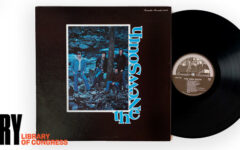
Lee ‘Boy’ Sexton, the legendary drop-thumb (clawhammer) banjo stylist and two-finger picker from Letcher County, Kentucky, passed away on February 11, 2021. He was 93 years of age.
Born in 1927, Lee Sexton worked as a field hand to earn the $1 he needed to buy his first banjo – a homemade wooden fretless model with a groundhog skin head – when he was seven years old. He received lessons from his father and uncles, one of whom was Morgan Sexton, another revered banjo player with a fluid two-finger picking style. Roscoe Holcomb was a cousin.
Sexton learned to play the fiddle and to sing as well.
Growing up, he worked in the mines during the week and played his banjo during weekends, usually for house parties or corn shuckings. Then he started playing square dances and went to a banjo contest at the ballpark in Whitesburg, Kentucky, winning first prize.
Sexton began performing professionally in 1941, with some radio work – one of these was WMVA in Martinsville, Virginia – and with fiddler Marion Sumner (1920-1997), whom he met that year. He said out of all of his career, he learned the most from Sumner. The duo worked together over a period of 50 years.
When he was 23 years old his right hand was crushed in a coalmining accident, forcing him to start playing a two-finger banjo style that he developed himself. He continued in various mines until his retirement from that occupation due to black lung. Whereupon he turned to farming to make a living, working the land on which he was born and raised.
His Whoa Mule CD includes recordings from a 1952 home recording with fiddler Fernando Lusk to recordings made in 2001.
This rendition of the tune is from 1989 …
Film directed by Herb E. Smith
Although unable to make a living in music, Sexton continued playing in the Appalachian region with the Lee Sexton Band, and into his ’90s Sexton remained an active performer and teacher.
In 1999 he was the recipient of the Kentucky Governor’s Award for Lifetime Achievement in the Arts.
Lee Sexton, along his wife Opal, has been the subject of a documentary, Linefork ….
The premiere showing took place on April 19, 2016, at the Visions du Réel Film Festival in Nyon, Switzerland.
He featured in Searching For The Wrong-Eyed Jesus from BBC, Arena (2004), as well as in the Loretta Lynn film, Coal Miner’s Daughter, playing banjo during the square dance scene.
David Holt, Host of PRIs Riverwalk Jazz, once said of Lee Sexton ….
“[He] has been something of a legend among those who love old time mountain music. For years, homemade tapes have been eagerly passed from one banjo enthusiast to the next. . . Lee Sexton is one of the finest traditional old time banjo players in the country.”
R.I.P., Lee Sexton.
A Discography
Lee Sexton
- Whoa Mule (June Appal JA0051, released 1989)
- Whoa Mule (June Appal JA0080 (CD), 2001) – This album contains about half of the recordings from the previous June Appal Recordings release by the same title, and includes newer material not previously released.
- Lee Sexton & Family (Field Recorders’ Collective FRC105, 2006) – Recordings from the collection of Ray Alden
Various Artists
- Mountain Music of Kentucky (Folkways FA 2317, 1960)
- Fox Chase and St. Louis Blues
- Mountain Music of Kentucky (Smithsonian Folkways CD 40077, 1996)
- St. Louis Blues, Pretty Polly, Fly Around and Fox Chase
- Classic Old-Time Music from Smithsonian Folkways (SFW 40093, 2003)
- Classic Banjo (Smithsonian Folkways SFW CD 40209, 2013)
- Fox Chase
Morgan Sexton
- Rock Dust (June Appal JA0055, March 27, 1989)
- Shady Grove (June Appal JA0066, 1992)
Lee Sexton played fiddle on both these albums.










